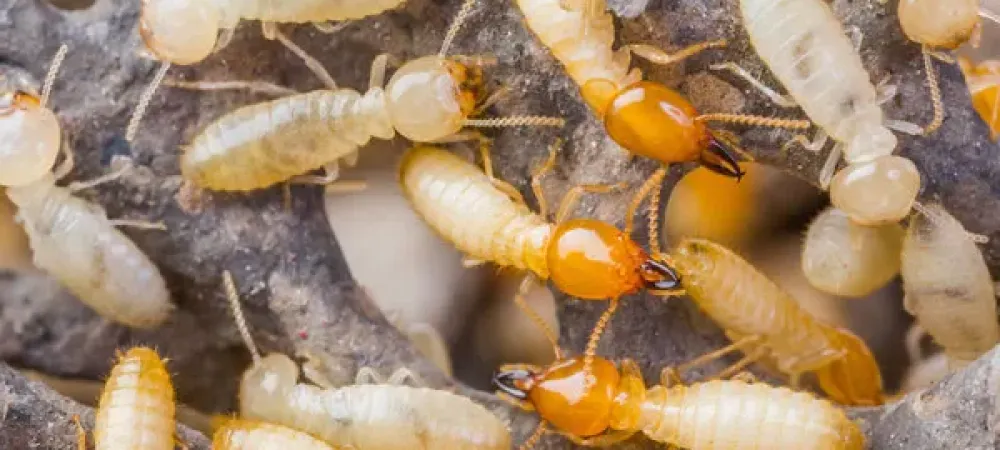Recognizing the Most Common Signs of Termites in Your Arizona Home

Termites, often referred to as "silent destroyers," are small but mighty pests that can wreak havoc on homes, causing extensive damage before homeowners even realize they have an infestation. In Arizona, where the warm climate is conducive to termite activity, it's crucial to be vigilant and proactive in identifying signs of these destructive insects. In this blog, we will delve into the most common signs of termites in Arizona homes and provide valuable insights on how to detect and address these silent invaders.
Mud Tubes
One of the hallmark signs of termite presence in Arizona homes is the formation of mud tubes. Subterranean termites construct these pencil-sized tubes from soil, wood particles, and their saliva. These tubes serve as protective pathways between their nests and the food source (wood in your home). Inspect the foundation, walls, and any wooden structures for the presence of these mud tubes, especially areas in contact with soil.
Hollow-Sounding Wood
Termites feast on wood from the inside out, leaving a thin outer layer that may sound hollow when tapped. Regularly check wooden surfaces such as floors, walls, and furniture for any unusual sounds or signs of hollowness. If you notice areas that seem hollow, it could be an indication of termite activity.
Presence of Termite Swarmers
During termite swarm season, you may observe winged termites flying around lights or windows. These swarming termites, also known as alates, leave their nests to establish new colonies. While these swarmers are not the ones causing structural damage, their presence is a clear indication that a termite colony is nearby. If you notice swarmers indoors, it's crucial to investigate further.
Discarded Wings
After finding a suitable location for a new colony and mating, termite swarmers shed their wings, which can be found near windowsills, light fixtures, or other entry points. Keep an eye out for discarded wings, especially during termite swarm season, as this may mean that termites have decided to establish a new colony in your home.
Frass (Termite Droppings)
Termite droppings, also known as frass, resemble tiny wood-colored pellets. These droppings can accumulate near termite nesting sites or on surfaces beneath infested wood. If you notice small piles of frass, it's a strong indicator of termite activity.
Tightening or Stiffening of Doors and Windows
As termites consume wood, the structural integrity of wooden elements in your home can be compromised. This may lead to doors and windows becoming difficult to open or close. If you experience sudden changes in the operation of doors and windows, it could be a sign of termite damage.
Sagging or Buckling Floors
Severe termite damage can result in sagging or buckling floors. As termites weaken the structural support of wooden flooring, it may start to warp or deform. Regularly inspect your floors for any signs of irregularities, and pay close attention to areas with wooden substructures.
Cracked or Bubbling Paint
Termites can cause paint to bubble or crack as they tunnel through the wood beneath the surface. This occurs when they disturb the paint from within the wooden structure. Keep a close eye on painted surfaces, especially if they are adjacent to wooden areas prone to termite activity. If you notice unusual paint damage, investigate further to rule out termite infestation.
Moisture Accumulation
Termites are attracted to moisture, as it softens wood and makes it easier for them to feed. Excess moisture around your home can create an ideal environment for termites. Check for leaking pipes, clogged gutters, or any other sources of water accumulation. Addressing moisture issues can help make your home less attractive to termites.
Tunnels in Wood
Inspect wooden structures for the presence of tunnels or galleries. Subterranean termites, common in Arizona, create tunnels within the wood as they consume it. Look for any holes that might serve as a termite entry. Break open any suspicious-looking wood to examine the interior for these intricate tunnel networks. If you find such tunnels, it's a clear indication of a termite infestation.
Termite Noise
While it may be challenging to hear, some homeowners report a soft clicking sound coming from termite-infested wood. This noise is produced by soldier termites as a form of communication. If you suspect termite activity, try listening closely in quiet areas near wooden structures to detect any unusual sounds.
Visual Identification of Termites
In some cases, you may actually see the termites themselves. Subterranean termites, for example, are cream-colored insects with straight antennae. If you come across live termites in or around your home, it's a clear sign of an active infestation. However, termites are generally elusive, so their presence may not always be visibly obvious.
Professional Termite Inspection
Understanding these obvious signs of termite infestation is crucial for every Arizona homeowner. Regular inspections, maintaining a dry environment, and promptly addressing any issues can significantly reduce the risk of termite damage.
But if you are worried you might be sharing your home with these destructive pests, it may be time to call a professional pest control company. Experienced termite exterminators are able to conduct detailed inspections and perform targeted termite treatments. If you live in the Phoenix area and are looking for the best local termite control, call Workman Pest Control today. With same-day termite inspections, family- and pet-safe treatments, on-going monitoring, and our satisfaction guarantee, we are sure to get rid of termite for good! Contact our team today.
FAQ About Termites in Arizona
In this FAQ section, we address common queries about termite infestations in Arizona homes, shedding light on the types of termites prevalent in the region, guidance on addressing termite damage, and insights into preventive measures. Whether you're grappling with mud tubes on the side of your house or seeking advice on termite prevention, these frequently asked questions aim to provide homeowners in Arizona with valuable information for protecting their homes from these silent invaders.
Can I Use DIY Methods to Treat Termite Infestations?
While some over-the-counter products claim to treat termite infestations, DIY methods are often not as effective as professional treatments. Termites can be elusive and may require targeted approaches based on the specific type of termite and the extent of the infestation. Professional pest control services have access to specialized treatments and equipment, ensuring thorough eradication and preventing future infestations. Attempting DIY methods may lead to incomplete eradication, allowing the infestation to persist and cause further damage.
How Can I Prevent Termite Infestations in My Arizona Home?
Preventing termite infestations involves a combination of proactive measures. Ensure proper drainage around your home to minimize moisture accumulation, as termites are attracted to damp environments. Regularly inspect and seal any cracks or crevices in your home's foundation and walls. Keep firewood, mulch, and other wooden materials away from the perimeter of your house. Additionally, scheduling annual termite inspections with a professional pest control service can help identify potential issues before they escalate.
What Are The Most Common Types of Termite in Arizona?
Arizona is home to several termite species, but the most prevalent and destructive ones are subterranean termites, particularly the Desert Subterranean Termite (Heterotermes aureus) and the Arid-land Subterranean Termite (Reticulitermes tibialis). Other types of termites common in Arizona include Western Drywood Termites (Incisitermes minor) and Pacific Dampwood Termites (Zootermopsis spp.). These types of termites thrive in the warm, arid climate of the region, making them significant threats to homes and structures.
When is Termite Season in Arizona?
Termite season in Arizona typically coincides with the warmer months, particularly from late spring to early fall. Subterranean termites, common in the region, are known to swarm during this period, seeking new locations to establish colonies. However, it's essential to note that termite activity can persist year-round in the warm climate of Arizona, making regular inspections crucial for early detection and intervention.
Why Are There Mud Tubes on the Side of My House?
Mud tubes on the side of your house are a telltale sign of subterranean termite activity. These tubes are constructed by termites as protective passageways, allowing them to travel between their nests in the soil and the wooden structures of your home without exposure to external elements or predators. The mud tubes help maintain a humid environment, which is essential for their survival. If you observe these tubes, it indicates an active termite infestation that requires immediate attention.
